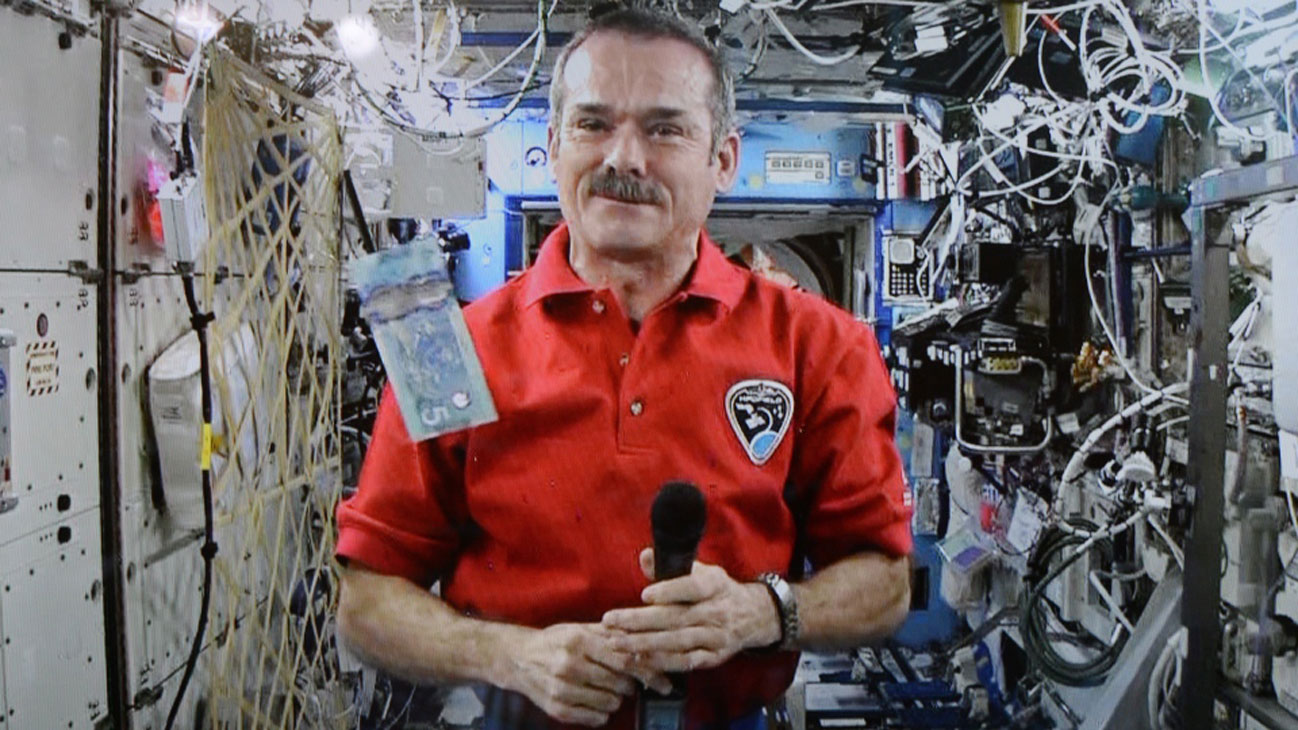Called “the most famous astronaut since Neil Armstrong,” Colonel Chris Hadfield brings the glory of science and space travel to everyone he encounters. And, as of last Thursday, Canadians will continue to be reminded about his involvement in space every time they pull a five-dollar bill out of their pocket. Having debuted the new polymer bill while in space, Col. Hadfield was also on hand last week to present the bill once more at a recent press conference:
The last of Canada’s polymer bills were put into circulation by the Bank of Canada on Thursday, with the transition to the plastic cash set to take about two years.
The $5 and $10 notes were unveiled at simultaneous news conferences in Longueuil, Que., and Vancouver respectively.
Bank of Canada governor Stephen Poloz, on hand at the Quebec event, touted the quality of the polymer bills, “or as we say in Oshawa, plastic.”
“The $5 and $10 bank notes tell a story about the frontiers of our country and even our universe,” Poloz said at the Canadian Space Agency headquarters.
The $5 bill symbolizes Canada’s contribution to space exploration and the back of the note depicts Canadarm 2 and Dextre, a two-armed, $200-million robot currently in use on the International Space Station.
The $10 bill pays tribute to Canada’s railway, a great engineering feat that linked the country’s eastern and western frontiers by what was, at the time, the longest railway ever built. It shows The Canadian, Via Rail’s passenger train which operates between Vancouver and Toronto, winding through the Rockies.
Also in attendance at the space agency was astronaut Chris Hadfield, who unveiled the bill while on the International Space Station last April.
That same $5 bill — a prototype sent up to the station with Hadfield — was returned Thursday to the Bank of Canada, which will display it at its money museum, currently under renovation.
The bill Hadfield brought with him didn’t have a serial number on it. It was rushed as Hadfield left for the space station in December, a bank spokesman said Thursday.
“It flew up with me on the Soyuz and came back with me five months later so it spent 146 days in space and (went) 2,336 times around (the world), which is just under 100 million kilometres,” Hadfield said.
It’s believed to be the only Canadian currency ever to make it to space.
“To take something to the space station gives it an inherent, large amount of value,” Hadfield said. “It’s not something we normally take up to space, but this was a real special exception.”
Meanwhile, the $10 bill was launched in Vancouver on the 128th anniversary of the driving of the last spike to complete Canada’s railway.
“We’re proud to see the legacy of ‘The Canadian’ train celebrated on the bank note (and) it pays tribute to the many who worked so hard to make it happen,” Via Rail head Marc Laliberte said at the West Coast event.
Polymer versions of the $100, $50 and $20 bills have already been released. The new notes were introduced into circulation gradually, beginning in 2011.
Bank of Canada analyst Michel Lebeau estimated it would take about two years to fully introduce the $5 and $ 10 bills. The gradual switch will allow businesses to upgrade technology and also allow financial institutions to transfer the paper bills back to the central bank.
“For us, the series is entirely in circulation,” Lebeau said. “We’re intentionally doing it slowly for those reasons.”
Any paper bills still floating around by late 2015 will still be accepted, Lebeau said.
The bills were touted by deputy Bank of Canada governor Tiff Macklem as “safer, cheaper and greener.”
“They are making history, they’re a first for Canada,” said Macklem.
About a half-dozen countries have a full complement of polymer bank notes, although Macklem said Canada’s are the first to have holographic technology.
They are less expensive because they last longer than the old cotton cash.
Canada’s central bank says the notes are expected to last between two and three times longer than their predecessors.
An RCMP spokesman said the number of counterfeit dollars has reduced dramatically with the introduction of polymer bills.
“There used to be about 400 out of a million that were counterfeit on the market and now we’re at 27, which is a huge decline,” said Cpl. Daniel Michaud, a Quebec-based counterfeit expert with the RCMP.
The $20 and $100 bills pose the biggest problem for counterfeiting. Roughly half of the $20 bills in circulation are the paper version.
“It will take some time so it’s a matter of staying vigilant with paper money,” said Michaud.

